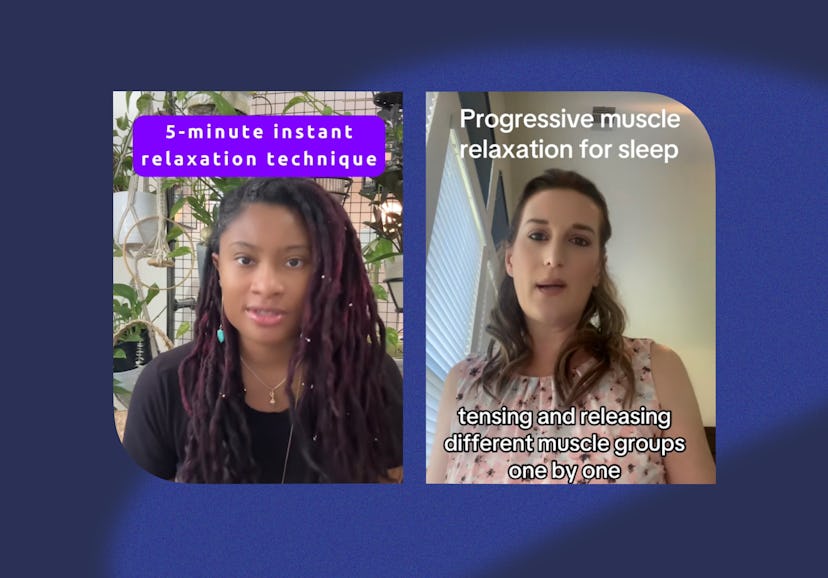Wellness
“PMR” Is The Expert-Approved Hack For Falling Asleep ASAP
Do this when you can’t fall asleep.

When you’re stressed out and constantly on the go, it can be tough for your body to tell when it’s finally time to wind down, relax, and fall asleep. Even if you take a hot shower or drink some tea before bed, it’s often no match for the physical stress that builds up throughout the day.
If you’re tense and anxious, it makes sense why you’d lie there for hours staring at the ceiling, or cricketing your feet together to no avail. This is where PMR, or progressive muscle relaxation, comes in. On TikTok, creator @wasabiwellness said PMR is her number one tip for de-stressing. It’s something you can do at your desk at work — or while lying in bed.
“The magic of PMR is that you purposefully build up tension in your body and then release it, letting that tension melt away into pure relaxation,” she said in a clip. “It’s like tricking your body into chilling out.”
Of course, it’s called “progressive muscle relaxation” because you quite literally progress through each area of your body, tensing and then releasing every muscle group, until each one feels soft and relaxed. It’s a good hack to try when you’re stressed, as well as when you can’t seem to snooze. Here’s what to know.
Why Is PMR Good For Sleep?
A PMR session, especially when combined with good sleep hygiene — think dark room, aromatherapy, and white noise — should have you sleeping in no time. According to Dr. Hana Patel, a NHS general practitioner and resident sleep expert at Time4Sleep, this relaxation trick relieves stress and anxiety, but it also works wonders for sleeplessness and insomnia.
“The technique allows you to become aware of any physical tension your body is carrying, and then release it,” she tells Bustle. “It helps to calm both the body and mind, making it easier to fall asleep faster.” Combined with slow, steady breaths, it’s essentially a mindfulness technique, too.
Instead of worrying about your day, it allows you to feel grounded and relaxed. “Deep breathing also stimulates the vagus nerve, lowering heart rate and blood pressure, as well as cortisol,” she adds. “This can counteract stress and anxiety, helping to prepare your body for sleep.”
By releasing tension from your muscles, you also send a sweet little message to your brain that all is well and you’re safe and sound, and that stimulates the parasympathetic nervous system, which plays a central role in you falling asleep. “Even a short session can cause you to feel more calm,” she says.
PMR can help you sleep more deeply, too. “This happens because with more relaxed muscles, the body can more easily fall into and maintain deeper stages of sleep,” Patel says. These deeper stages are particularly important for physical recovery and cognitive function, she notes, which is why, after a PMR sesh, you might wake up feeling more refreshed than usual.
How To Do PMR Before Bed
Dr. Leah Kaylor, Ph.D, MSCP, a psychologist and sleep expert, recommends doing PMR about 20 minutes before you plan to fall asleep. Once you’re ready for bed, climb in and get comfy. Slow your breathing to a four to five-second inhale, followed by a four to six-second exhale.
- To start PMR, squeeze your hands into gentle fists for about five seconds, then release
- Repeat at least two times or for about 20 seconds max
- Between each rep, allow your body to relax
- Notice what it feels like as the tension leaves your body
- Savor the difference between the tensed-up version of you and the one who’s starting to let go.
- Next, tighten the muscles in your biceps, neck, and shoulders. Without straining too hard, squeeze this area, holding for five seconds, then release and repeat.
- Move to your face and jaw. Scrunch up your facial muscles and lips, then relax. Scrunch again, then relax.
- Follow that with a light squeeze in your abs, then your glutes, taking care to avoid injured areas or stopping if it hurts.
- One by one, move down your body as you clench and release each area — all the while remembering to breathe slowly in and out.
- After squeezing your glutes, focus your attention on your thighs. Squeeze those, then tense up your calves, and finally move down to your feet. Scrunch your toes and then relax.
In total, your PMR should take about five to 10 minutes, and it should leave your body feeling like a relaxed pool of Jell-O. If you wake up in the middle of the night, you can repeat a shortened PMR to settle back down, Kaylor says, especially if you still notice tension in your body.
While it should help you fall asleep right away, adding PMR to your nightly wind-down routine will make it even more effective in the future, she says, as your body gets used to its benefits. Keep it up, and you should consistently get the sleep of your dreams.
Sources:
Dr. Hana Patel, NHS general practitioner, resident sleep expert at Time4Sleep
Dr. Leah Kaylor, Ph.D, MSCP, psychologist, sleep expert